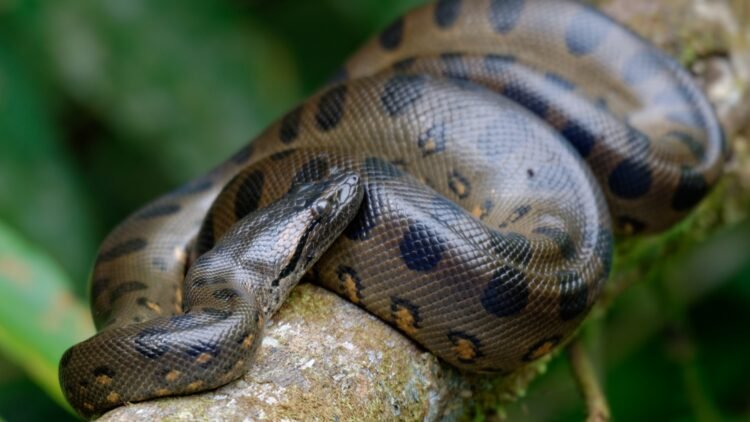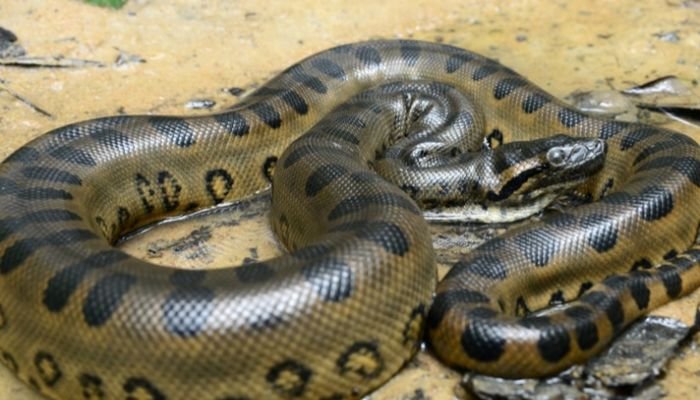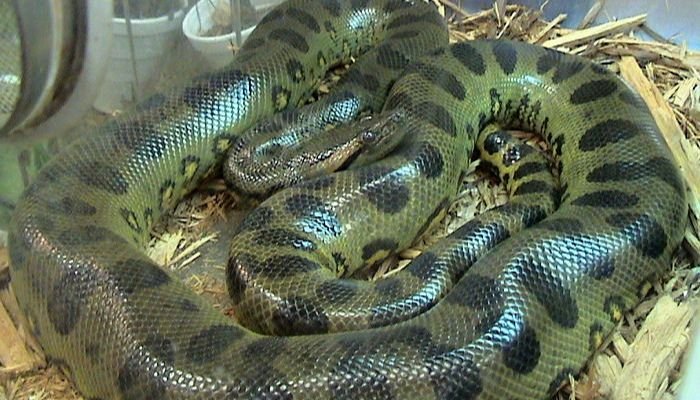
In South American tropical rainforests, enormous Green Anaconda snakes can be encountered. It is simultaneously the longest and heaviest species of serpent. Green anacondas are semi-aquatic by nature and spend a great deal of time in or near water. They have powerful constrictors that can kill large prey such as caimans and capybaras. These incredible snakes regulate the number of prey in their region, maintaining the equilibrium of the ecosystem and serving a vital ecological function.. Here are Green anaconda Guide on Food, Habitat, Size, Lifespan & Predators below-
Green Anaconda Stats in Table format
The stats are given below for Green anaconda
| Reptiles List | Green anaconda |
|---|---|
| Family | Boidae |
| Type | Snake |
| Size | Large |
| Length | Green anaconda: Up to 20-30 feet (6-9 meters) |
| Color | Green anaconda: Typically has a green coloration with darker markings. |
| Weight | Green anaconda: Can weigh between 200 to 300 pounds or more.. |
| Lifespan | 10-30 years (or more) |
| Reproduction | Ovoviviparous, gives live birth |
| Gestation Periods | it is ovoviviparous, meaning that the female retains the eggs internally until they hatch. The gestation period for the Green anaconda is estimated to be around 6 to 7 months. During this time, the female carries the developing embryos within her body. |
| Endangered Status | Least Concern (IUCN Red List) |
| Features | Large size, muscular body, excellent swimmer |
| Country & Areas | South America, specifically found in the Amazon rainforest and other freshwater habitats in countries like Brazil, Peru, and Venezuela. |
Green Anaconda Natural Habitat and Distribution
One of the largest and best-known snake species is the green anaconda (Eunectes murinus). Its natural area encompasses much of South America, where it thrives in a variety of wet environments. Large populations of this serpent can be found across South America, but it is most commonly linked with the Amazon Basin and the countries of Brazil, Peru, Venezuela, and Colombia.
Green Anaconda Physical Features and Adaptations
Here are some information about Green Anaconda
1. Body Structure
The green anaconda is a large, thick-bodied snake. It’s the longest snake in the world, second in weight only to the reticulated python. Green anacondas can grow to be 20-30 feet long as adults, with females often being considerably longer than their male counterparts. They are able to stay almost totally submerged thanks to their broad, flat head, which allows their eyes and nose to remain above the water’s surface.
2. Coloration and Patterns
The green anaconda’s name comes from the fact that this snake is typically a greenish tint, making it blend in with its aquatic and forest habitats. The body can be a range of greens from olive to dark, with black splotches running the length of the animal. This design helps the snake blend in with its surroundings and ambush its prey.
3. Defense Mechanisms
The green anaconda is a formidable constrictor that does not use poison. When threatened, it may hiss loudly, puff itself out to look bigger, and strike. However, it primarily uses its constricting capacity to defend itself. The green anaconda may subdue large creatures by wrapping its muscular body around them and suffocating them.
Green Anaconda Diet and Feeding Habits
Here are some information about Green Anaconda
1. Diet Type
The green anaconda is a carnivorous reptile, thus it eats mostly other creatures. Prey items include mammals, birds, fish, and even other reptiles. As an ambush predator, it waits for prey to approach before swooping in for a fast bite with its razor sharp teeth.
2. Preferred Food Sources
The green anaconda’s diet shifts as it grows and changes with the seasons. Adult anacondas can take down capybaras, deer, and wild pigs with ease. Young anacondas may eat fish, birds, and rodents.
3. Feeding Schedule
Ectothermic creatures like green anacondas need to find other ways to keep warm. As a result, their metabolic rate and the frequency with which they eat are sensitive to their surrounding surroundings. Since they require more time to digest their food, they may only eat once every few weeks, or even months.
Green Anaconda Housing and Enclosure Requirements
Here are some information about Green Anaconda Housing and Enclosure Requirements
1. Terrarium Size and Setup
A big, well-ventilated enclosure is necessary for keeping a green anaconda as a pet. A proper enclosure for a full-grown anaconda would measure at least 20 feet in length and 6 to 8 feet in width, with plenty of places to hide and climb. As anacondas are notoriously powerful and skilled escape artists, it is crucial to provide a secure enclosure with a locking lid.

2. Substrate Options
The snake’s enclosure should be furnished with substrate that is ecologically appropriate. Mulch, cypress mulch, and coconut husk bedding are all acceptable alternatives. Humidity levels can be controlled by ensuring that the substrate is moist at all times.
3. Temperature and Lighting
A warm and humid climate is necessary for the survival of green anacondas. Daytime temperatures should range from 80 to 90 degrees Fahrenheit (27 to 32 degrees Celsius), with a basking area heated to about 90 to 95 degrees Fahrenheit (32 to 35 degrees Celsius). Mid-seventies Fahrenheit (23-25 degrees Celsius) is not unheard of at night. The snake is able to properly regulate its body temperature when a temperature gradient is provided. In order to provide the snake with enough UVB light for vitamin D production, full-spectrum UVB lighting is required.
4. Humidity and Water Needs
The green anaconda’s survival depends on constant high humidity. A large dish of water for the snake to soak and bathe in should be provided, and the relative humidity should be kept between 60 and 80 percent. During the shedding process, when the snake’s skin needs to be removed, this is very crucial.
Green Anaconda Behaviour and Temperament
Here are some information about Green Anaconda Behaviour and Temperament
1. Activity Levels
Because of their nocturnal habits, green anacondas are rarely seen during the day. They like to find shady, cool places to relax and digest during the heat of the day.
2. Social Behaviour
The green anaconda is a solitary animal that forages and lives independently. Beyond mating and having offspring, they don’t engage in any other significant social actions.
3. Handling and Taming
Only highly skilled professionals should attempt to handle a green anaconda. Captive-bred animals nonetheless retain their size and strength, making them a threat. Even with consistent handling, a green anaconda may retain some of its wild temperament and defensiveness, making it clear that taming it is not the same as taming a domesticated animal.
Green Anaconda Breeding and Reproduction
Here are some information about Green Anaconda Breeding and Reproduction
1. Mating and Courtship Rituals
During the wetter months, when the water is more plentiful, green anacondas tend to have their offspring. Using their superior sense of smell, males seek out and woo potential mates by rubbing their bodies together. Males put themselves in harm’s way during the breeding process since the females can be violent.
2. Incubation and Hatchlings
In order to fertilize her eggs, a female green anaconda can store sperm for months after a successful mating. Instead of depositing eggs, she gives birth to healthy offspring. Typically, pregnancy lasts between seven and eight months. Female anacondas have been recorded to have births of more than 40 babies at once. Baby anacondas are completely self-sufficient right away.
Green Anaconda Common Health Issues and Veterinary Care
Here are some information about Green Anaconda Common Health Issues and Veterinary Care
1. Respiratory Infections
If the humidity and temperature of a green anaconda’s enclosure are not stable, the snake may have a respiratory illness. Wheezing, mouth-breathing, and increased mucus production are all indicators of respiratory distress. Husbandry practices, such as providing an optimal climate, can reduce the incidence of respiratory issues.
2. Parasites:
Parasites, both internal and external, are a fact of life for green anacondas and other reptiles. Parasites can be detected and treated with regular fecal examinations and veterinarian checkups.
3. Metabolic Bone Disease
Metabolic bone disease can develop in green anacondas when they aren’t exposed to enough UVB illumination or have enough calcium in their food. As a result of bone weakness, this disorder can lead to both malformations and breaks. Preventing this condition requires a healthy lifestyle, including exposure to sufficient UVB illumination and a diet rich in calcium and other necessary elements.

Importance of Regular Vet Check-ups
Keeping captive green anacondas healthy and happy requires routine veterinary examinations. A trained vet familiar with reptiles can administer preventative care exams, look for signs of illness or parasites, and advise on diet and upkeep. The snake’s life expectancy and quality of life could be greatly enhanced via early diagnosis and treatment of potential health problems.
Conclusion
The green anaconda is a rare reptile that lives in the rainforests and rivers of South America because of its massive size and special adaptations. It is one of the most fascinating reptiles because of its large size, vibrant green colour, and impressive capacity for constriction. Some people may choose to maintain green anacondas as pets despite the fact that doing so calls for a great deal of expertise to suit the animal’s specialized needs. The green anaconda is an important top predator in its ecological environment, helping to keep prey populations in check. However, they face several risks as a result of habitat destruction and human activity, making conservation efforts crucial to their continued existence in the wild. Let us, as we gain more knowledge about these amazing reptiles, also work to ensure that future generations have access to their natural habitats.
Q: What is the family and Type of Green anaconda?
A: The Green anaconda is a species of family Boidae. The Famous Green anaconda is a member of the family Snake.
Q: What is the average size of an Green anaconda?
A: The average adult Green anaconda is Large between Green anaconda: Up to 20-30 feet (6-9 meters).
Q: How long can a Green anaconda grow in size in length?
A: Green anaconda is Large in size and The green anaconda is a massive snake that can grow up to an impressive length of 20-30 feet or 6-9 meters.
Q: What colors do Green anaconda come in?
A: The green anaconda is known for its vibrant green coloration, which is accentuated by darker markings..
Q: How big can a Green anaconda get in weight?
A: The green anaconda is a massive snake that can reach weights of 200 to 300 pounds or even more.
Q: What are the special Features of a Green anaconda?
A: Green anaconda are Large size, muscular body, excellent swimmer
Q: How long do Green Anaconda live?
A: The usual lifespan of a Green anaconda is The green anaconda has a lifespan of 10-30 years, and in some cases, they can live even longer.
Q: What food does the Green anaconda eat?
Large fish, birds, reptiles, and mammals make up the bulk of the green anaconda’s diet. They’ve been documented eating capybaras, caimans, and even deer. They only eat when they have to, and after a big meal they can go weeks or months without food. They hunt by ambushing their prey, which they do both in the water and on land due to their carnivorous diet.
Q: What is the best habitat for an Green anaconda?
A: A green anaconda thrives in environments with both water and land. The Amazon rainforest and its adjacent areas are home to numerous populations of these huge snakes. They thrive in hot, sticky climates with abundance of water for swimming and hunting. The anaconda has easy access to cover and potential prey in the dense rainforest vegetation. They are skilled swimmers and frequently wait for prey while concealed in the water. For the green anaconda to thrive, its habitat needs to provide a wide variety of fish, birds, and mammals for it to eat.
Q: How do Green anaconda give birth?
A: Green anaconda are Ovoviviparous, gives live birth
Q: How long is the gestation period for an Green anaconda?
The female Green anaconda is ovoviviparous, meaning she carries her eggs until they hatch, hence their gestation time is about a year. The average Green anaconda pregnancy lasts between 6 and 7 months. Embryos develop inside the woman while she is pregnant.
Q: What is the natural behavior of a Green anaconda?
There are primarily two types of green anaconda: The green anaconda, often called the common anaconda, is a massive snake native to South America that does not bite. Some individuals can grow to be over 20 feet long and 550 pounds heavy, earning it the nickname “the world’s largest fish.” The green anaconda’s natural behavior involves being semi-aquatic, spending a lot of time in or near water. It can swim quite well and maintain its submerged position for extended periods of time. The powerful muscles of its body are used to constrict its victim until it suffocates and is then swallowed whole. The green anaconda is nocturnal and prefers to spend its time alone. It plays a crucial role in its environment as a predator, regulating the numbers of animals that rely on it for survival.
Q: Is the Green anaconda endangered?
A: The Green anaconda is Least Concern (IUCN Red List).
Q: What are the prey of Green anaconda?
The green anaconda eats fish, birds, turtles, caimans, and capybaras, among other creatures. It is the top predator in its ecosystem, and it kills its prey by overwhelming them with its size and strength. The green anaconda is notorious for ambushing its prey in the water before snatching them with its strong jaws and keen teeth. It’s an opportunistic predator that can easily take down animals several times its size.
Q: Do Green Anaconda have any Predators?
Vipera anaconda Predators of the green anaconda include huge cats like jaguars and caimans, as well as birds of prey like harpy eagles. The green anaconda, one of the world’s largest snakes, is a common target for these predators’ hunting and eating efforts. As part of their natural diet, they hunt down and kill anacondas using their superior strength, speed, and cunning.
Q: How Fast Does Green anaconda Move?
A: The green anaconda can move at speeds of up to 10 miles per hour on land and can swim at speeds of up to 5 miles per hour in water.
Q. What is the Bite Force of a Green anaconda in PSI?
A. Bite Force in PSI of a green anaconda is around 90 pounds per square inch.
Q: Can we keep Green anaconda as pets?
Unfortunately, green anacondas can’t be kept as pets. Because of their size and strength, these snakes have specific needs and require a proper habitat. They are dangerous and difficult to manage because they can reach 30 feet in length and weigh more than 500 pounds. Green anacondas are considered too dangerous to be kept as pets in many areas.
I hope you like reading on Green Anaconda FAQ Guide on Food, Habitat, Size, Lifespan, and Predators.
